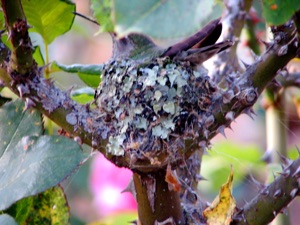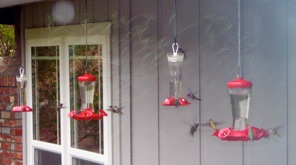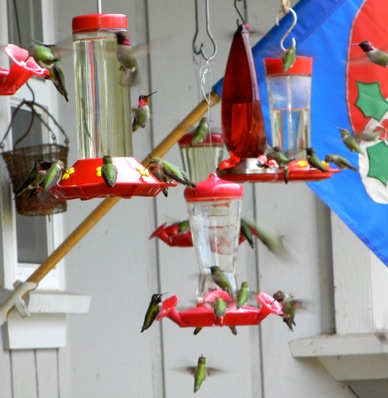Hummingbirds


The hummingbirds never flew south a few years back. I
thought their continued presence was perhaps an indication
they knew something that we didn’t, i.e. that we would have
a mild winter. Ha! No such luck. Mild is a relative word,
however.
While some of you dig out from under three feet of snow, I
break the occasional layer of ice on the birdbaths. That
fall the hummers had a conference and voted to stay around.
At least 70 overwintered. It is a marvel to us and to any
friends who visit and must walk among the six feeders
across the front porch and try to reach the door.
Some friends stand out there for five minutes, stock still, watching the hummers feed and listening to the twits and continuous hum of their wings. Reluctant to enter, our friends finally ring the doorbell. The hummingbirds search for food all day long, both at the feeders and out in the winter garden. But the real spectacle is just at dusk for their regular evening feeding frenzy before they find protected roosting spots and go into a torpor for the cold night.
In March, there is very little in the way of
typical hummingbird plants out in the garden.
Only rosemary, daffodils, a pear and a peach tree,
borage, and wild mustard are in bloom. They
must fly far and wide during the day to get
the nutrition they need.
During their feeding times at the house, they
are now beginning to engage in mating activities,
including preening, flashing their display feathers,
and doing their graceful face-to-face up and
down air-dancing. The females are the usual
aggressors (the guys don’t mind). All of this
eventually leads to attached flying in tandem,
then separating and blithely heading back to
feed some more.
Around here, there is plenty of moss, lichen
and spider webs for their nests. I hang a wire
basket filled with dryer “fluff” out near the
feeders.They have been pulling it through the
mesh and heading off with a bill full of fluff
to line their nests. Babies must be on the way!
To the right is a lichen-covered nest in a rose
bush with mom sitting on her eggs (2010 photo).
Below that is a miniature nest holding two tiny
hummer babies waiting to be fed. This is a March
2011 photo taken in S. Calif. where their
seasons are a month or two ahead of us here in
the north end of the state.
Later in the spring when my perennial and
native plants grow and push out their blooms, the
hummingbirds will have plenty of natural nectar.
Right now I make about a half-gallon of sugar-
water every day; the hummers fly about to seek
nectar and tiny insects for protein during the day.
It’s easy to create your own hummingbird
garden. Red means food. Though it seems to be the most
reliable color that attracts them, you don’t need to have an
all-red garden. Once they find food in your garden, they will
seek nectar in a variety of different color flowers. Plant
many varieties so that you will have nectar-filled blooms
throughout the spring, summer, and fall.
Hummingbirds like narrow tubular or trumpet-shaped
flowers facing out--a perfect match for their long bills. Some
of their favorites include Coral bells, Four-o-clocks, Ribes,
Bee balm, Trumpet creeper, Scarlet sage, Texas sage,
Red hot poker, Cape fuchsia, Cardinal flower, Scarlet
monkey flower, Penstemon, Delphinium, Pineapple guava,
Cleome, Petunias, and many others. The Anna’s below feeds
on Salvia leucantha (Mexican bush sage); purple works, too.
Do not be discouraged because you think you don’t have
enough space; even the right plants in containers
will attract hummingbirds.
The home-made nectar: mix 4 parts water
and 1 part white sugar in a pan. Stir to
dissolve the sugar and boil for two minutes.
Cool and fill your feeders. Store the rest in
the fridge. Clean your feeders at least every
three days, using a bottle brush and a splash of
white vinegar. Rinse well.
The hummingbirds that visit our gardens I
believe include: Anna’s, Allen’s, and perhaps the
Rufous. Males are more brilliant than the females.
Hummers love sprinklers, the fine spray on a
hose, red hats and T-shirts. Most are curious and
friendly, hovering close to inspect your red
baseball cap or red rose on your sun hat. They will
not attack you.
If you have fed hummers for a long time and
stop, they will be most unhappy and boycott you
for days or a week until they can trust that you’ve
resumed. And if they do leave town for the
winter, you can be sure that when the weather
turns warm again, they will be right back in your
yard and at your feeder expecting their favorite
flowers and sugar-water. You have conditioned
them! Don’t let them down. Grab your camera and
a nearby seat and enjoy the antics of these tiny aerobatic birds--the only ones who can’t walk because their little feet are made only for perching. Click on References for further reading. See more photos in Habitat. Happy Hummingbird Gardening!
Go to HOWIE for information on Howie’s Hungabird Dilemma.
Hummingbird Gardening Made Easy









